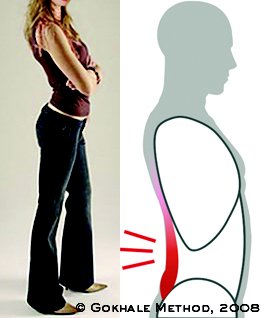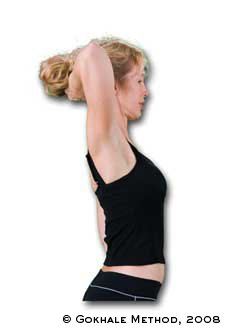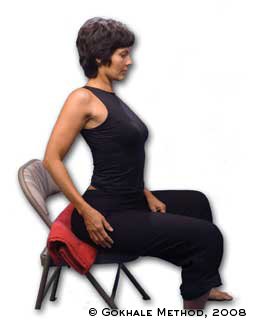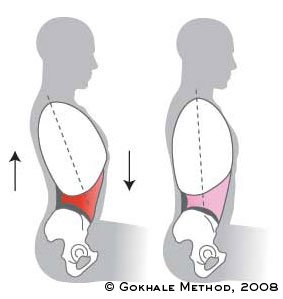Fixing a Sway Back
Though a sway back is commonly perceived as good posture, most people recognize it to be a problem. What is the best way to fix a sway? And for those of you who don’t quite know, what is a sway?

Arching the low back is common and problematic.
A swayback is an inappropriate curve usually in the upper lumbar spine. It is frequently the result of trying to “sit up straight,” or “stand up straight” in a sustained way. Sometimes it is the result of modern activities, most notably women’s gymnastics, women’s ice-skating, women’s ballet and misguided forms of yoga.

The directive to "stand up straight" often results in a swayed low back.
Swaying compresses the discs and decreases circulation around the spine.
I know this problem intimately. Having done a great deal of misguided gymnastics and yoga growing up, I had a very pronounced swayback in my twenties. People complimented me on my posture (sways certainly make you appear upright), but I blame the sway for weakening my lumbar spine and the resulting problems I had with my back in my mid-twenties (this is no longer such a young age to have back problems, I regretfully note).

Esther demonstrating her previous habit of arching the back to be "upright"
The conventional fix for a sway is to tuck the pelvis. But this causes as many problems as it solves. It is true that tucking the pelvis usually flattens a swayback, and often feels good because it stretches out the low back muscles, but tucking the pelvis also compromises the wedge-shaped L5-S1 disc. In my own case, I suspect that the tucking exercises I was taught after my initial episodes of back pain in my teens and early twenties contributed to my more serious L5-S1 disc herniation problem in my later twenties.
The better way to address a sway is to tuck the ribs. By this I mean rotate the ribcage forward so as to make the lower border of the ribcage flush with the abdomen. As the lower ribcage descends and retreats into the contour of the torso, the lower back lengthens, flattens and has a healthier architecture.

Tucking the rib cage-- a healthy way to flatten the low back.
This move is usually quite difficult for those who need it most. If you have been swaying your back for years/decades, tucking the ribs makes you feel hunched (it shows whatever hunch you have, which you now want to address directly with shoulder rolls, neck lengthening, etc.) and ape-like. A quick glance in a mirror should reassure you that you don't look the way you feel. This is always a major aha! moment in our Gokhale Method Foundations course. So there you have it - tuck your ribs, not your pelvis!

Comments
Thanks for the info in this
Thanks for the info in this entry on sway back. Have singers commented on this position? It seems like this position would encourage breathing laterally and/or into the lower back which are all good in my book.
Thanks for posting this important subject,
David
I totally agree. I think its
I totally agree. I think its because I expand my ribs so much ( i breath deeply) that I need to also be more aware of expanding laterally rather than that which can force my ribs forward. This blog post above is really like a revelation. I mean i remmeber that being the way I corrected my posture previously when doing hand stands but go figure planted firmly on my feet or lying down I need the subtle remembrance to tuck my ribs into alignment.
Singers seem to appreciate
Singers seem to appreciate the techniques we teach, including rib anchor and especially inner corset. For singing, diaphragmatic breathing becomes more important as it's a way of controlling the voice, projection, and such. I'm eager to learn more from the singers among us!
I just have to say God Bless
I just have to say God Bless you. Im a yogini and have dabbled with acro so i know exactly what you mean by tuck your ribs, im a bit out of practice though and forced into an office situation for a stretch. I also have a bad lifelong habit of sway back. Anyway I never do this, but i signed up to comment and say this was the frst post that gave good advice. Especially that bit about how tucking the tailbone can excerbate it. I had to sign on and say how grateful I am a second ago I was tucking my tailbone for the hundredth time in pain and now I've tucked my ribs and its completely gone! Super grateful Godbless.
Super cool!
Super cool!
Add New Comment
Login to add commment
Login